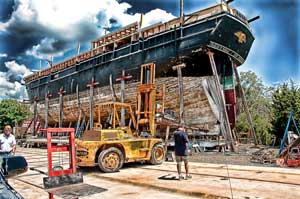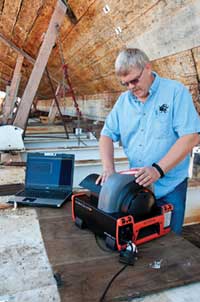If you haven’t taken your favorite old car out for a spin in several months,
you might first clean it up, change the oil, check the brakes and top off the coolant
to assure a pleasant ride. If you are taking the world’s last remaining wooden
whaling ship out for a sail for the first time in decades, you’ll want to
go over it with a fine-tooth comb.

The dry-docked whaling ship Charles W. Morgan undergoes imaging during a five-year restoration project. Courtesy of Scott Kalmus.
Built in 1841, the Charles W. Morgan sailed from the Atlantic
to the Pacific, searching for the giants of the oceans. In all, the crew of the
Morgan harvested more than 2500 of the creatures, bringing home tens of thousands
of gallons of whale oil and tons of keratinous baleen. The oil was used to light
lamps in homes and on the streets; the strong, flexible baleen found its way into
parasols, corsets and buggy whips.

The ScanX Discover, a portable x-ray scanner from Allpro Imaging, is a key instrument
for nondestructively exploring the construction of the Morgan. Courtesy of Scott
Kalmus.
The Morgan plied its trade for eight decades, calling at times
both San Francisco and New Bedford, Mass., its home port. A hundred years after
it was built, the ship was brought to its new home at the seaport museum in Mystic,
Conn. In the years since, curators and restoration experts at Mystic Seaport have
worked to keep the historic vessel in good repair, but slow deterioration still
occurred.
By the new century, however, the decision was made to give the
Morgan a full restoration, with the ultimate purpose of sailing her once again on
the open sea. To make this happen, the museum set out two years ago to make an exhaustive
map of the ship.

Using laser metrology technology and x-ray computed radiography,
restorers are recording every plank, beam, nail and peg used to construct the vessel.
For example, a nondestructive testing system made by Allpro Imaging of Melville,
N.Y. – Yes, Melville. Of course, Melville – was used to locate the bronze
joiners called drift pins that shipwrights used to join wooden beams together.
Shown is an x-ray image of a drift pin. Courtesy of Allpro Imaging.
Allpro Imaging’s x-ray computed radiography system, called
the ScanX Discover, also showed where the pins had corroded from exposure to seawater.
The information gathered by these tools is guiding the modern shipwrights toward
a complete overhaul of the proud Morgan and will help the museum achieve its goal
of putting wind into the ship’s sails by the summer of 2013.

Technicians ready an x-ray scanner for a look at the Morgan's keel. Courtesy of Mystic Seaport: Museum of America and the Sea.

This is a sample 3-D laser scan of the Morgan. Courtesy of Mystic Seaport: Museum of America and the Sea.